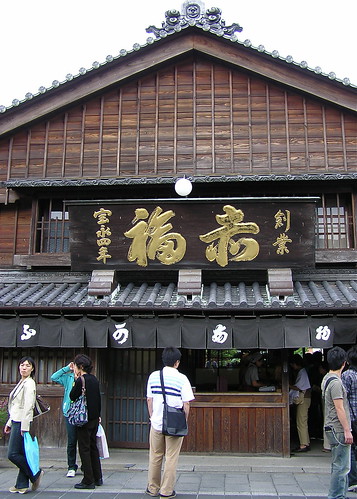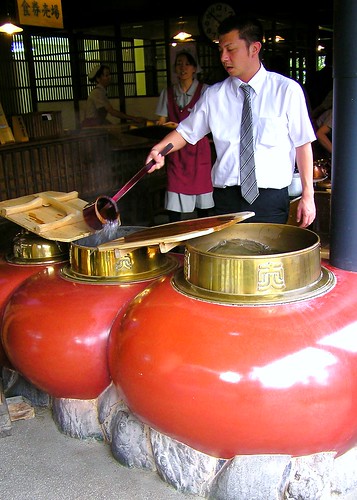
Day sixty-eight: Akafuku Honten
Preface: I spent the six days prior to my visit to Akafuku Honten in the grip of the worst flu I've ever experienced. My daily routine included shivering, sweating, hallucinating, rolling around on the floor, and praying for repatriation and/or death. Eating, however, was not among my activities, except for the handful of raw almonds I swallowed each day just to keep the furnace going. Unfortunately, as I was wallowing in misery my very expensive Japan Railpass was ticking away. So I packed some almonds and the lightest bag possible and left Tokyo at the crack of dawn, bound for Ise, home of Japan's most sacred Shinto site and its most infamous sweet shop. By the the time I dragged into town it was past 4pm; I was sick, tired, and unable to stomach even the sight of the notorious rice balls. So instead of my usual tasting notes I offer some shots of the Akafuku shop, as well as a relevant passage from a draft grad school paper. Oh, and servings range from ¥700 to ¥1000.
...
On October 19, 2007, Japanese authorities ordered a manufacturer and retailer of traditional confectionery to cease production indefinitely. Food inspectors had found that the company, Akafuku, was systematically falsifying the freshness of its goods by such means as misdating packages, freezing products, and reusing ingredients.
Compared with a rash of recent food safety scandals in the Japanese dairy, meat-processing, and fishing industries, Akafuku’s distribution of less-than-fresh sweets seems relatively benign. Indeed, although the company was found to have followed its dubious practices for more than 30 years, it was a whistle-blower who exposed them, not an outbreak of food poisoning, nor even a customer complaint.
Why, then, did Japanese authorities act so forcefully? Why has the Akafuku story attracted widespread national and international attention? And why do disappointed would-be customers now pose to have their pictures taken outside the shop’s closed doors? These reactions suggest that in Japan traditional confectionery is something other than mere food, and that a confectioner’s transgressions therefore pose a threat to something other than health or hygiene.
So what is Japanese confectionery? This question drives the research proposal outlined in this paper. Using documentary and artefactual evidence, I will begin to “define” Japanese confectionery in terms of its materiality, history, and aesthetics. While I will offer some commonly-accepted answers, I will also seek to complicate these, suggesting field-based activities that could reveal a more thorough picture of Japanese confectionery’s social and cultural relevance. While working to displace cross-cultural comparisons with direct evidence, I will employ theories developed in Mintz’s (1986) history of sugar consumption in Britain to make sense of historic shifts in the significance of Japanese confectionery.
In Akafuku’s case, the confections in question are balls of glutinous rice paste coated with a “jam” of sweetened red beans. Yet they are also the product of three centuries of continuous practice and knowledge transmission, and of historical forces that made possible the combination of indigenous staples and exotic, expensive, refined white sugar. Elaborately wrapped, they are popular souvenirs of a pilgrimage to nearby Ise Jinja, Japan’s most sacred Shinto shrine. And until recently, they were a reminder to sensualists and fatalists alike that sweetness must be savored before the opportunity passes; Akafuku had always claimed that any unsold sweets were destroyed at the end of each day.
Akafuku’s confections, in short, are not just balls of rice, beans, and sugar. Despite being highly perishable goods of negligible nutritional value, such confections are invested with significance. My investigation will seek to uncover how this investment takes place..."
Postscript: Obviously, Akafuku is back in business and going strong. On the day I visited people were waiting up to half and hour just to be seated. Mmmm, infamy...



No comments:
Post a Comment